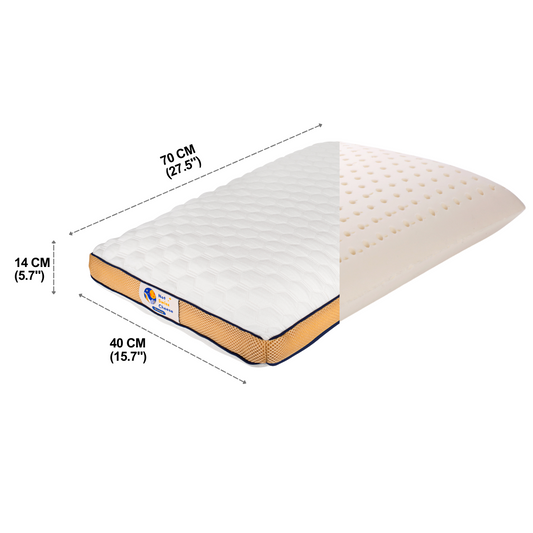REM (Rapid Eye Movement) sleep is a crucial phase of your sleep cycle where your brain is highly active, your body is paralyzed, and vivid dreams occur. It makes up about 20–25% of your total sleep time, or roughly 2 hours each night for most adults. During REM sleep:
- Brain Activity: Almost as active as when awake, aiding memory, learning, and emotional processing.
- Body Changes: Heart rate and blood pressure rise, breathing becomes irregular, and muscles are temporarily paralyzed (except for those controlling breathing and eye movement).
- Dreams: Most vivid and emotional dreams happen during this stage.
- Benefits: Helps consolidate memories, regulate emotions, and support brain development.
To improve REM sleep:
- Stick to a consistent sleep schedule.
- Create a cool, dark, and quiet sleep environment.
- Avoid caffeine, alcohol, and screens before bed.
REM sleep is vital for mental and emotional health. If you experience disturbances like acting out dreams, consult a healthcare professional to address potential issues.
How to Get More REM Sleep
Sleep Cycle Basics
Sleep follows a structured pattern, cycling through distinct stages roughly every 90 minutes. On average, you complete 4 to 6 of these cycles each night.
4 Main Sleep Stages
There are four main stages of sleep: three non-REM stages (N1, N2, and N3) and one REM stage.
| Sleep Stage | Type | Duration | Key Characteristics |
|---|---|---|---|
| Stage 1 (N1) | NREM | 1–7 minutes | Light sleep; easy to wake up |
| Stage 2 (N2) | NREM | 10–25 minutes | Body cools down; heart rate slows |
| Stage 3 (N3) | NREM | 20–40 minutes | Deep sleep; physical recovery occurs |
| REM | REM | 10–60 minutes | Dreams happen; brain activity spikes |
Non-REM sleep makes up about 75% of your total sleep time, with Stage 2 alone accounting for nearly half of it. The remaining 25% is allocated to REM sleep.
REM Sleep Features
The first REM phase kicks in about 90 minutes after you fall asleep. Early in the night, these REM periods are short - around 10 minutes - but they stretch longer as the night goes on, with the final REM phase lasting up to an hour.
In the earlier part of the night, deep sleep (N3) dominates. As morning approaches, REM phases grow longer. For adults, getting 105 to 135 minutes of REM sleep within a 7–9 hour sleep period is ideal.
REM sleep patterns also differ by age. Newborns, for instance, spend about 8 hours a day in REM sleep, which plays a key role in their development. As people age, their sleep structure shifts - older adults often have less deep (N3) sleep and changes in REM patterns.
Next, we’ll dive into what happens during REM sleep and how it impacts your body and mind.
What Happens During REM Sleep
Body and Brain Changes
During REM sleep, your body and brain go through rapid changes. Your brain becomes almost as active as when you're awake, with oxygen use increasing by 20%. This surge in activity creates a unique state: your mind stays alert, but most of your muscles enter a temporary paralysis called atonia. The only muscles that remain active are those needed for breathing and eye movement. While your body remains still, your eyes move quickly beneath your eyelids, and you might experience small facial twitches or slight limb movements.
Here’s a quick look at some physical changes during REM sleep:
| Physical Change | Description |
|---|---|
| Breathing | Becomes faster and irregular |
| Heart Rate | Rises noticeably |
| Blood Pressure | Increases beyond normal sleep levels |
| Body Temperature | May fluctuate from its baseline |
| Brain Waves | Shift to low-amplitude, high-frequency beta waves |
"REM sleep is also characterized by waves of brain activity that are similar to those of awake periods, based on electroencephalography (EEG) recordings. Although much of sleep is dominated by high-amplitude, low-frequency waves, the cortical waves that occur during REM sleep include low-amplitude, high-frequency beta waves, which are present during awake periods. For this reason, REM sleep is sometimes called paradoxical sleep."
- Karin Akre
These changes create the perfect conditions for the vivid dreams that often occur during this stage.
Dreams and REM Sleep
REM sleep is the primary stage for vivid dreaming. Around 80% of dreams that people remember happen during REM sleep, compared to just 7–50% in non-REM stages. REM dreams tend to stand out - they’re often more emotional, complex, and even bizarre compared to those in other sleep stages.
The brain's limbic system, which manages emotions, becomes highly active during REM sleep. This explains why dreams during this stage often feel emotionally intense. Stress can amplify this, with people frequently reporting more vivid dreams centered on negative emotions during tough times.
Interestingly, during REM sleep, the brain is highly active but disconnected from external stimuli, creating a distinct state of awareness.
Here’s how REM sleep changes with age:
- Newborns spend about eight hours in REM sleep daily.
- Adults average around two hours of REM sleep each night.
- REM sleep makes up roughly 19% of total sleep time in healthy adults.
This stage is essential for emotional well-being and mental health. For instance, studies show that 50–70% of people with post-traumatic stress disorder frequently experience recurring nightmares.
sbb-itb-7fb8e9c
Benefits of REM Sleep
Memory and Brain Function
REM sleep plays a key role in strengthening memory and improving brain performance. During this stage, your brain organizes new information, consolidates memories, and fine-tunes neural connections by trimming unnecessary ones and reinforcing critical pathways.
Research highlights this connection. For example, a study involving college students found that longer REM sleep during naps led to better working memory accuracy. Additionally, in older adults, a 1% decrease in REM sleep was linked to a 9% higher risk of developing dementia.
"Encoding is certainly required but not sufficient for [episodic] memory formation. If encoded information is not consolidated after exposure to new experiences, you simply won't remember it." - George Dragoi, MD, PhD, associate professor of psychiatry and neuroscience at Yale School of Medicine
Managing Emotions
REM sleep isn't just about memory - it also helps regulate emotions. During this stage, your brain processes emotional experiences while keeping stress hormone levels low. This allows emotional memories to be handled without triggering stress responses.
| Emotional Benefits of REM Sleep | How It Works |
|---|---|
| Stress Relief | Low stress hormones during REM allow emotional processing |
| Emotional Memory Processing | Brain activates memories while reducing emotional intensity |
| Improved Emotional Regulation | Helps distinguish between real threats and harmless stimuli |
"REM is very unique because it's the only time that area of the brain is completely silent. One theory is that this allows you to wipe the slate clean before you start again the next day. If you have less REM, then you have less of an opportunity to reduce your overall levels of norepinephrine, which will make you more reactive the next day to a given stimulus." - Shira Lupkin, Researcher with the Center for Molecular and Behavioral Neuroscience at Rutgers University
In addition to emotional balance, REM sleep supports critical developmental processes.
Growth and Development
REM sleep is especially important during early life, aiding both brain and physical development. This stage contributes to the formation of neural circuits, improvement in behavior, and the development of visual and motor systems.
Key contributions of REM sleep include:
- Development of neural circuits and improved behavior
- Maturation of the visual cortex and motor systems
- Selective pruning of dendritic spines
- Strengthening of new synaptic connections
One study demonstrated REM sleep's role in visual development. Subjects deprived of REM sleep showed impaired brain growth due to reduced activation of ERK, a protein essential for brain health.
"It had been theorized that REM sleep is important for brain development, because infants spend up to 70 percent of their sleep time in REM sleep, as compared to adult humans, who typically only spend about 20 percent of their sleep in the REM stage." - Marcos Frank, Professor of Medicine, Washington State University
How to Get Better REM Sleep
Stick to a Consistent Sleep Schedule
Going to bed and waking up at the same time every day can improve the quality of your REM sleep. Aim for 7–9 hours of sleep each night, even on weekends. This routine helps your body establish a rhythm, making it easier to move through the sleep phases, including REM.
Create the Perfect Sleep Environment
Once your sleep schedule is in place, focus on making your bedroom a haven for rest. Keep the room cool, dark, and quiet to encourage the natural drop in body temperature that supports deeper REM sleep. Adjust the lighting, reduce noise, and maintain a comfortable level of humidity to enhance your sleep experience.
Invest in the Right Sleep Accessories
The right sleep products can make a big difference. A good mattress and pillow can help maintain proper sleep posture, which is essential for quality rest. For instance, a natural latex pillow, like a Talalay Medium Soft Latex Pillow, offers consistent support for your neck, promotes spine alignment, and helps regulate temperature for a more comfortable night’s sleep.
REM Sleep Problems
REM sleep plays a crucial role in mental and emotional health, but issues like REM sleep behavior disorder (RBD) can pose serious health concerns.
Acting Out Dreams
RBD is a condition where people physically act out their dreams during REM sleep. Normally, the body is paralyzed during this sleep stage, but RBD disrupts this process. It affects about 1% of people in the U.S., with the rate doubling to 2% in individuals over 50. Symptoms often include:
- Punching or kicking, which can lead to injuries for you or your partner
- Shouting or screaming during sleep
- Jumping out of bed, increasing the risk of falls
Related Sleep Disorders
RBD can be more than just a physical issue - it often points to underlying neurological problems. Studies show that 97% of people with isolated RBD eventually develop neurodegenerative conditions, such as Parkinson's disease, Lewy body dementia, or multiple system atrophy, typically within 14 years. Additionally, up to 36% of individuals with Type 1 narcolepsy report experiencing RBD symptoms. Certain medications, like some antidepressants, may also trigger RBD in about 6% of users.
Getting Medical Help
Addressing RBD early can reduce associated risks. If you or your partner notice violent movements or dream enactment disrupting sleep, it’s important to consult a sleep specialist. Treatment strategies may include making your sleep environment safer - removing sharp objects or adding cushioning - and, if necessary, taking medications like melatonin or clonazepam, as recommended by the American Academy of Sleep Medicine. Regular neurological check-ups can also help detect any related conditions early.
Summary
REM sleep makes up about 20–25% of your total sleep and plays a key role in strengthening memories and managing emotions.
Here are some ways to improve the quality and duration of your REM sleep:
-
Stick to a Regular Sleep Schedule
Go to bed and wake up at the same time every day, aiming for at least 7 hours of sleep. -
Set Up a Relaxing Sleep Environment
Keep your bedroom cool, dark, and quiet. Remove any electronics that might interfere with your ability to wind down. -
Adjust Your Evening Habits
Stay away from caffeine, tobacco, alcohol, and screens as bedtime approaches.
Taking steps to address REM sleep issues early can help protect your mental and emotional well-being. If you're dealing with disturbances in REM sleep, don’t hesitate to reach out to a healthcare professional.
"Sleep has been characterized as a brain state that optimizes memory consolidation, with different sleep stages playing specific roles".








